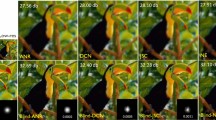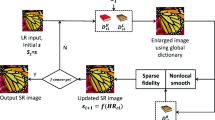Abstract
One of the most striking properties of natural image statistics is the scale invariance. Some earlier studies have assumed that the kurtosis of marginal band pass filter response to be constant throughout scales for a natural image. In our study, this assumption is loosened by adaptively estimating an optimal filter computation whose response distributions through scales have the least Kullback–Leibler divergence. The adaptive filter and its responses characterize the scale-invariance property more accurately and effectively and are further utilized to model the statistics scale-invariance prior in this paper. Extensive experiments on image super-resolution and de-noising manifest that the explored natural images scale-invariance prior model achieves significant performance improvements over the current state-of-the-art schemes.









Similar content being viewed by others
References
Mumford D, Gidas B (2001) Stochastic models for generic images. Q Appl Math 59(1):85–111
Srivastava A, Grenander U, Liu X (2002) Universal analytical forms for modeling image probabilities. IEEE Pattern Anal Mach Intell 24(9):1200–1214
Schellmann M, Gorlatch S, Meiländer D, Kösters T (2011) Parallel medical image reconstruction: from graphics processing units (GPU) to grids. J Supercomput 57(2):151–160
Skaruz J (2014) Two-dimensional patterns and images reconstruction with use of cellular automata. J Supercomput 69(1):9–16
Atick JJ (1992) Could information theory provide an ecological theory of sensory processing. Network 3:213–251
Bialek W (2002) In Physics of biomolecules and cells. In: Flyvbjerg H, Jülicher F, Ormos P, David F (eds) Proceedings of the Les Houches Summer School, Session LXXV, Springer-Verlag, Berlin, pp 485–577. arXiv:physics/0205030
Lim H-Y, Kang D-S (2013) Efficient noise reduction in images using directional modified sigma filter. J Supercomput 65(2):580–592
Weng C-Y, Zhang YH, Li LC, Wang S-J (2013) Visible watermarking images in high quality of data hiding. J Supercomput 66(2):1033–1048
Chen B-W, Chen C-Y, Wang J-F (2013) Smart homecare surveillance system: behavior identification based on state transition support vector machines and sound directivity pattern analysis. IEEE Trans Syst Man Cybern-Part A: Syst 43(6):1279–1289
Jiang F, Rho S, Chen B-W, Du X, Zhao D (2014) Face hallucination and recognition in social network services. J Supercomput. doi:10.1007/s11227-014-1257-z
Barlow HB (1961) Possible principles underlying the transformation of sensory messages. In: Rosenblith WA (ed) Sensory communication. MIT Press, Cambridge (Mass) London, pp 217–234
Simoncelli EP, Olshausen BA (2001) Natural image statistics and neural representation. Annu Rev Neurosci 24(1):1193–1216
Bialek W (2002) Thinking about the brain. Physics of bio-molecules and cells. Physique des biomolécules et des cellules. Springer, Berlin, pp 485–578
Zoran D, Weiss Y (2009) Scale invariance and noise in natural images. In: IEEE 12th international conference on computer vision, pp 2209–2216
Ruderman DL (1994) The statistics of natural images. Network 5:517–548
Field DJ (1987) Relations between the statistics of natural images and the response properties of cortical cells. J Opt Soc Am A 4:2379
Weiss Y, Freeman WT (2007) What makes a good model of natural images. In: IEEE conference on computer vision and patern recognition (CVPR), pp 1–8
Zhang H, Zhang Y, Li H, Huang TS (2012) Generative Bayesian image super-resolution with natural image prior. IEEE Trans Image Process 21(9):4054–4067
Lam E, Goodman J (2000) A mathematical analysis of the dct coefficient distributions for images. IEEE Trans Image Process 9(10):1661–1666
Bethge M (2006) Factorial coding of natural images: how effective are linear models in removing higher-order dependencies. J Opt Soc Am A Opt Image Sci Vis 23(6):1253–1268
Ruderman DL, Bialek W (1993) Statistics of natural images: scaling in the woods. In NIPS, pp 551–558
Srivastava A, Lee AB, Simoncelli EP, Zhu S-C (2003) On advances in statistical modeling of natural images. J Math Imaging Vis 18(1):17–33
Ruderman DL (1997) Origins of scaling in natural images. Vis Res 37:3385–3398
Domínguez-Molina J, González-Farías G, Rodríguez-Dagnino R, Monterrey I A practical procedure to estimate the shape parameter in the generalized Gaussian distribution. Technique report I-01-18\_eng. pdf. http://www.cimat.mx/reportes/enlinea/I-01-18_eng.pdf
Hou T, Wang S, Qin H (2011) Image deconvolution with multi-stage convex relaxation and its perceptual evaluation. IEEE Trans Image Process 20(12):3383–3392
Gluckman J (2006) Scale variant image pyramids. Comput Vis Pattern Recognit 2006 IEEE Computer Society conference on, vol 1. IEEE
Ren X, Malik J (2002) A probabilistic multi-scale model for contour completion based on image statistics. Computer vision–ECCV, Springer, Berlin, pp 312–327
Freeman WT, Jones TR, Pasztor EC (2002) Example based superresolution. IEEE Comput Graph Appl 22(2):56–65
Glasner D, Bagon S, Irani M (2009) Super-resolution from a single image. In: Proceedings of IEEE international conference on computer vision, Oct 2009, pp 349–356
Zhang H, Yang J, Zhang Y, Huang T (2010) Non-local kernel regression for image and video restoration. In: Proceedings of European conference on computer vision, 2010, pp 566–579
Yang J, Wright J, Huang T, Ma Y (2010) Image super-resolution via sparse representation. IEEE Trans Image Process 19(11):2861–2873
Baker S, Kanade T (2002) Limits on super-resolution and how to break them. IEEE Trans Pattern Anal Mach Intell 24(9):1167–1183
Li X, Orchard MT (2001) New edge-directed interpolation. IEEE Trans Image Process 10(10):1521–1527
Takeda H, Farsiu S, Milanfar P (2007) Kernel regression for image processing and reconstruction. IEEE Trans Image Process 16(2):349–366
Tappen MF, Russell BC, Freeman WT (2003) Exploiting the sparse derivative prior for super-resolution and image demosaicing. In: Proceedings of IEEE workshop statistics computer theories vision, Oct 2003, pp 1–24
Keys RG (1981) Cubic convolution interpolation for digital image processing. IEEE Trans Acoust Speech Signal Process ASSP–29(6):1153–1160
Zhang L, Wu X (2006) Image interpolation via directional filtering and data fusion. IEEE Trans Image Process 15(8):2226–2238
Zhang X, Wu X (2008) Image interpolation by adaptive 2-D autoregressive modeling and soft-decision estimation. Image Process IEEE Trans 17(6):887–896
Martin D, Fowlkes C, Tal D, Malik J (2001) A database of human segmented natural images and its application to evaluating segmentation algorithms and measuring ecological statistics. In: Proceedings of ICCV 2:416–423
Cai JF, Chan R, Nikolova M (2008) Two-phase methods for deblurring images corrupted by impulse plus Gaussian noise. Inverse Probl Imaging 2(2):187–204
Huang Y, Ng M, Wen Y (2009) Fast image restoration methods for impulse and Gaussian noise removal. IEEE Signal Process Lett 16(6):457–460
Li Y-R, Shen L, Dai D-Q, Suter BW (2011) Framelet algorithms for de-blurring images corrupted by impulse plus Gaussian noise. IEEE Trans Image Process 20(7):1822–1837
Hwang H, Haddad R (1995) Adaptive median filters: new algorithms and results. IEEE Trans Image Process 4(4):499–502
Acknowledgments
This work was supported in part by the Major State Basic Research Development Program of China (973 Program 2015CB351804), the National Natural Science Foundation of China under Grant Nos. 61272386 and 61100096, the National Science Council of the Republic of China under Grant Nos. 103-2917-I-564-058, and the Basic Science Research Program through the National Research Foundation of Korea (NRF) funded by the Ministry of Education (2013R1A1A2061978).
Author information
Authors and Affiliations
Corresponding author
Rights and permissions
About this article
Cite this article
Jiang, F., Chen, BW., Rho, S. et al. Optimal filter based on scale-invariance generation of natural images. J Supercomput 72, 5–23 (2016). https://doi.org/10.1007/s11227-015-1398-8
Published:
Issue Date:
DOI: https://doi.org/10.1007/s11227-015-1398-8




